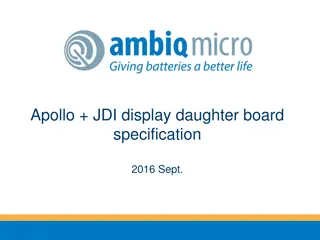Understanding LCD Display Technology and Its Operation Principles
LCD technology, used in various devices from televisions to calculators, operates by modulating light through ionized gases in small cells. LCDs consume minimal energy and are commonly found in digital wristwatches, mobile screens, and more, serving as efficient display solutions.
Download Presentation

Please find below an Image/Link to download the presentation.
The content on the website is provided AS IS for your information and personal use only. It may not be sold, licensed, or shared on other websites without obtaining consent from the author. Download presentation by click this link. If you encounter any issues during the download, it is possible that the publisher has removed the file from their server.
E N D
Presentation Transcript
TYPES OF TV BY TECHNOLOGY UNIT-3 LESSON-2
CONTENT Cathode ray tube TVs. Plasma display panels. Digital light processing. Liquid crystal display.(LCD) Organic light emitting diode.(OLED) Quantum light emitting diode.(QLED) Discuss the principle of operation LCD display.
CATHODE RAY TUBE TVS Application: In cathode ray oscilloscope. As a display device in radar. In tv. In computer monitor. PLASMA DISPLAY PANELS Application: In tv. In computer monitor.
DIGITAL LIGHT PROCESSING. Application: DLP Projectors. Holographic data storage. LIQUID CRYSTAL DISPLAY.(LCD) Application: The liquid crystal displays (LCDs) are used in aircraft cockpit displays. It is used as a display screen in calculators. For displaying images used in digital cameras. The television is main applications of LCD. Mostly the computer monitor is made up of LCDs. It is used in instruments panel where all the lab instruments uses LCD screens for display. The LCDs are commonly used in all the digital wrist watches for displaying time. The LCDs are used in mobile screens. It is also used in video players.
ORGANIC LIGHT EMITTING DIODE.(OLED) The television is main applications of OLED. Mostly the computer monitor is made up of OLEDs. It is used in instruments panel where all the lab instruments uses OLED screens for display. The OLEDs are commonly used in all the digital wrist watches for displaying time. The OLEDs are used in mobile screens. QUANTUM LIGHT EMITTING DIODE.(QLED) Automotive headlamps General lighting Traffic signals Camera flashes Lighted wallpaper Horticultural grow lights Medical devices.
PRINCIPLE OF OPERATION LCD The LCD is defined as the uses small cells and the ionised gases for the production of images. diode that The LCD works on the modulating property of light. The light modulation is the technique of sending and receiving the signal the light. through The liquid crystal consumes a small amount of energy because they are the reflector and the transmitter of light. It is normally used for seven segmental display.
CONSTRUCTION OF LCD The liquid crystals are the organic compound which is in liquid form and shows the property of optical crystals. The layer of liquid crystals is deposited on the inner surface of glass electrodes for the scattering of light. The liquid crystal cell is of two types; they are Transmittive Type and the Reflective Type. Transmittive Type In transmitter cell both the glass sheets are transparent so that the light is scattered in the forward direction when the cell becomes active. Reflective Type The reflective type cell consists the reflecting surface of the glass sheet on one end. The light incident on the front surface of the cell is scattered by the activated cell. Both the reflective and transmittive type cells appear brights, even under small ambient light conditions.
WORKING PRINCIPLE OF LCD When the potential carrier flows through the light, the molecular alignment of the liquid crystal disrupts, and they disturbances. The liquid becomes transparent when they are not active. But when they are active their molecules turbulence scattered of light in all directions, and their cell appears bright. This type of scattering is known as the dynamic scattering. produce causes
ADVANTAGES OF LCD The power consumption of LCD is low. The seven segmental display of LCD requires about 140 W which is the major advantages over LED which uses approximately 40mW per numeral. The cost of the LCD is low. DISADVANTAGES OF LCD The LCD is a slow device because their turning on and off times are quite large. The turn-on time of the LCD is millisecond while there turn off time is ten milliseconds. The LCD requires the large area. The direct current reduces the lifespan of LCD. Therefore, the LCD uses with AC supply, having the frequency less than 500Hz.
ASSIGNMENT Explain with useful block diagram working of LCD.
THANK YOU























